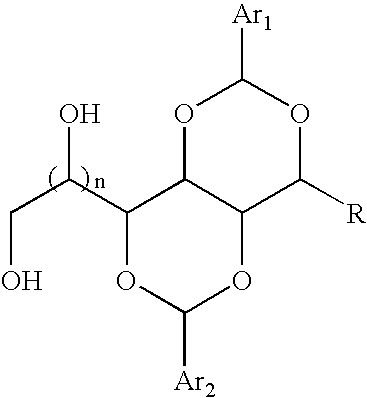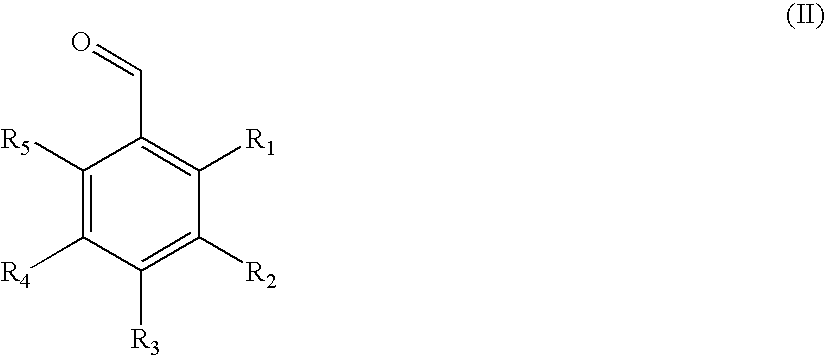Method of nucleating a polyolefin composition with acetal-based compounds
a technology of acetal and polyolefin, applied in the field of nucleating polyolefin compositions with acetal-based compounds, can solve the problem that the chemical arts are often unpredictabl
- Summary
- Abstract
- Description
- Claims
- Application Information
AI Technical Summary
Benefits of technology
Problems solved by technology
Method used
Image
Examples
example 1
1-Allyl Sorbitol
[0056]A 3 L, three-necked round bottom flask, equipped with heating mantle, stirrer, nitrogen inlet, and condenser, was charged with 900 mL of ethanol, 150 mL of water, 180 g (1.00 mole) of D-glucose, 119 g (1.00 mole) of tin powder (−100 mesh), and 121 g (1.00 mole) of allyl bromide. The mixture was stirred and slowly heated to reflux—a significant exotherm and gas evolution was observed at 60° C. The gray suspension was stirred at reflux for two days, in which time the reaction mixture turned an orange / brown color. Heat was removed and the mixture was allowed to cool to room temperature. The reaction was neutralized to pH=7 by adding approximately 200 ml of 5M NaOH aqueous solution. The suspension was filtered to remove solids, and the yellow solution was decolorized with multiple treatments of activated carbon. The activated carbon was removed by filtration, and the solvent was removed by rotary evaporation to isolate a white syrup. Typical yield was 200 g with th...
example 2
Bis-1,3:2,4-(4′-ethylbenzylidene) 1-Allyl Sorbitol
[0058]A 2 L reaction kettle, equipped with a stirrer and nitrogen inlet, was charged with 111 g (0.50 mol) of 1-allyl sorbitol syrup (product of Example 1) in 100 mL of 6N HCl solution. 134 g (1.0 mol) of 4-ethylbenzaldehyde in 800 mL of methanol was added to the reaction vessel. The clear solution was stirred for 48 hours, during which time a significant amount of white precipitate formed. The powder was isolated by filtration and washed with 250 ml of 1 M NaOH aqueous solution. The powder was suspended in water and further neutralized to pH=7 with a small amount of NaOH. The suspension was heated to boiling, then filtered. The white powder, was washed with 7×500 ml of boiling water. The washed powder dried overnight. The powder was then stirred in 500 mL of cyclohexane, heated until boiling, filtered, and washed with 2×250 ml of boiling cyclohexane. The isolated white powder was dried in a vacuum oven to give 107 g of product, m.p....
examples 3 – 8
EXAMPLES 3–8
[0059]A variety of allyl-substituted dibenzylidene-based (DBS) molecules were synthesized using the procedures similar to the one described in Example 2 above. Structures are shown in Table I, with measured values for melting point. All derivatives had NMR consistent with the indicated structures; and purities of at least 95%, based on GC-MS.
PUM
| Property | Measurement | Unit |
|---|---|---|
| hydrogen pressure | aaaaa | aaaaa |
| temperature | aaaaa | aaaaa |
| melting point | aaaaa | aaaaa |
Abstract
Description
Claims
Application Information
 Login to View More
Login to View More - R&D
- Intellectual Property
- Life Sciences
- Materials
- Tech Scout
- Unparalleled Data Quality
- Higher Quality Content
- 60% Fewer Hallucinations
Browse by: Latest US Patents, China's latest patents, Technical Efficacy Thesaurus, Application Domain, Technology Topic, Popular Technical Reports.
© 2025 PatSnap. All rights reserved.Legal|Privacy policy|Modern Slavery Act Transparency Statement|Sitemap|About US| Contact US: help@patsnap.com



